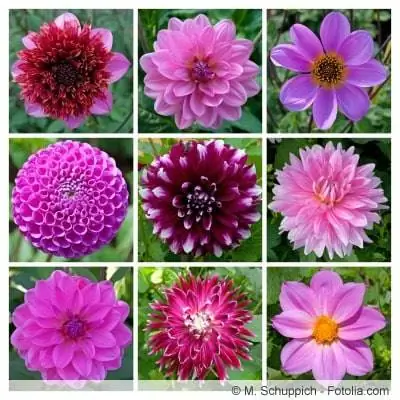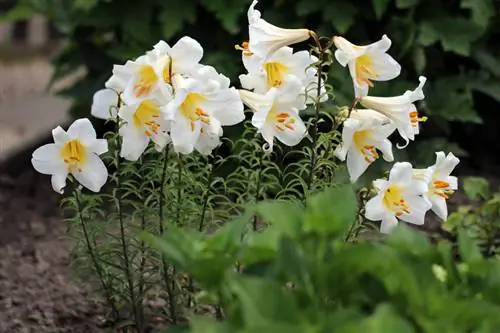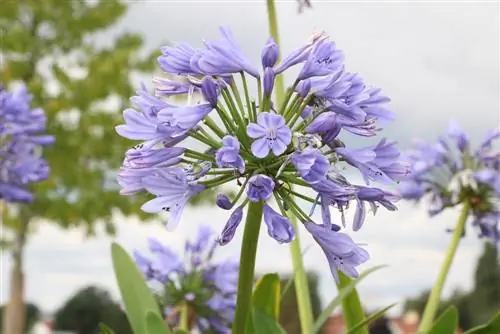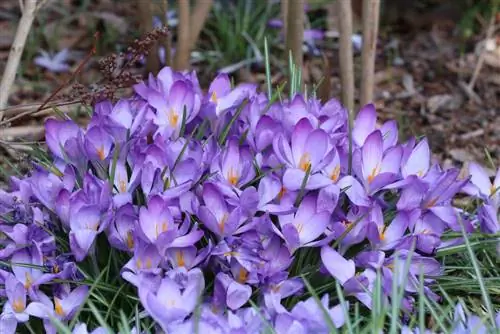- Author admin [email protected].
- Public 2023-12-17 03:39.
- Last modified 2025-01-24 12:45.
Botanically, lilies belong to the monocots of the Liliaceae family. Many of the lily species in this genus are also hardy in our latitudes. The above-ground parts move in in autumn and the plants for next year are then formed in their bulbs. There is now a huge range of different hybrids of various lily species available to buy in stores. It's definitely worth taking a closer look at the most beautiful variants with all their we alth of colors and growth forms.
Systematics
The approximately one hundred species of lilies have been crossed with each other for decades in order to obtain particularly beautiful and robust hybrids. Some species crossed with each other produce hybrids. These are plants that have different characteristics from their parents and are capable of reproduction. Other attempts to cross different lily species yield no seeds.
Harold Frederick Comber introduced a new classification of Lilium in 1949. He divided the species, including their hybrids, into seven sections (later classified: divisions):
- American Section
- Asian Section
- Candidum section
- Longiflorum section
- Martagon Section
- Oriental Section
- Trumpet Section
- (Other and wild forms)
The most popular hybrids native to Germany come from the lily species:
- Fire lily (Lilium bulbiferum)
- Madonna lily (Lilium candidum)
- Tiger lily (Lilium lancifolium)
- Turkish Lily (Lilium martagon, Lilium cernuum)
- Trumpet lilies (Lilium aurealianum)
- Japanese mountain lily (Lilium auratum)
Likelihood of confusion

Iris and African lily neither belong to the Liliacae family, although they have the term “lily” in their name. They belong to the iris family (Iridacecae) and amaryllis family (Amaryllidaceae). Both families come from the order Asparagales and not Liliales.
Hybrids
Lilium auratum
This mountain lily from Japan usually has eight or more fragrant, large, beautiful flowers on one stem. Hardy onion with light cover. She likes it cool and moist.
- ‘Cupido’: It has lots of red flowers
- 'Marseille': white flowers with a delicate pink touch
- 'Miss Lucy': light pink, double flowers without stamens
- 'Sphinx': deep red flower without stamens
Lilium Aurelian
The trumpet lilies usually have a strong scent and prefer a location in light shade.
- 'Royal Gold': golden yellow flowers up to 1.50 m high
- 'Pink Perfection': pink flowers with a white central stripe, height up to 1.50 m
- Longiorum 'Elegant Lady': flowers pink, smells strong; suitable as a cut flower.
- ‘White American’: white-flowering trumpet lily; is particularly suitable as a pot flower; Flowers up to nine centimeters large; pleasant smell; 60 cm height.
- ‘White Elegance’: pure white flowers; Trumpet lily with large flowers;
Lilium bulbiferum
Most fire lily hybrids are bright orange with brown spots. The umbels, up to a meter high, can bear up to twenty flowers. They prefer it sunny with slightly calcareous soil.
Lilium candidum
In its natural form, the Madonna lily is pure white, grows up to one meter high and produces up to eight fragrant flowers. It is hardy and should be covered with brushwood in harsh climates.

Lilium cernuum
The Turkish lily blooms in shades between purple, pink and light purple. The flowers have a delicate scent and grow up to seven centimeters large.
- Martagon 'Album': pure white flowers; grows low; is suitable for rock gardens
- Lilium hansonii: Golden Turk's Lily; produces golden yellow flowers with dark speckles; quickly forms large clumps
- Lilium henryi: Giant Turkish lily; very fast-growing and robust; orange-yellow flowers; unscented; particularly undemanding and long-lasting
Colors
Lilies of all types and shapes have an impact thanks to their strong colors. Here is a small list of lily species and
Hybrids according to their colors:
White
Lilium Aurelian ‘White American’
white trumpet flowers; fragrant;
Lilium Aurelian 'White Elegance'
Trumpet Lily; Flowers large, pure white;
Lilium martagon ‘album’
pure white; lots of small, nodding flowers
Lilium regale ‘Siberia’
lots of white flowers
Lilium shelves 'Starling Star'
creamy white, speckled flowers
Lilium auratum ‘Mister Ed’
pure white; strongly scented;
Lilium candidum, wild form pure white; strongly scented

Yellow
- Lilium hansonii, golden turk lily; golden yellow flower
- Lilium Leichtlinii, flowers bright yellow, with speckles
- Lilium monadelphum
- Caucasus lily; yellow flowering
- Lilium pyrenaicum
- Flower yellow; black spotted, Lilium speciosum 'Citronella'
- flowers lemon yellow, Lilium auratum 'Royal Gold'
- golden yellow flowers, Littonia modesta
- Climbing Lily; yellow flowers
- Orange, Brown, Lilium 'Apeldoorn'
- orange-red flowers, Lilium Barcelona,
- orange-red flowers; radiating yellow from the inside, Lilium tigrinum 'splendens'
- flowers orange; brown speckled, Lilium bulbiferum 'Orange Triumph'
- flowers orange to yellow; in umbels, Lilium bulbiferum (umbellatum)
- Natural form; bright orange flowers, Lilium pardalinum
- glossy, orange flowers; spotted rusty brown; many flowers; Panicles
Red
- Lilium auratum ‘Imperial Crimson’
- deep crimson flowers, Lilium auratum ‘Nobility’
- ruby red flowers, Lilium auratum 'Cupido'
- red flowers, Lilium auratum 'Sphinx'
- blooms deep red; double flowers, Lilium speciosum var. rubrum
- crimson flamed flowers; deep red speckled, Lilium tenuifoliu
- Coral Lily; flowers coral red; Lilium tigrinu
- Tiger Lily; orange-red flowers; black spotted; nodding;
Pink, Purple
- Lilium Aurelian 'Pink Perfection', pink with white central stripes, Lilium auratum 'Trance'
- light pink flowers; strongly scented; large flowers, Lilium auratum 'Journeys End'
- pink-red blooming; wide white border, Lilium longiflorum 'Elegant Lady'
- pink blooming; strongly scented, Lilium cernuum
- Natural form; Blooms purple-pink to light purple; delicately scented, Lilium auratum 'Marseille'
- white flowering with a delicate pink tinge, Lilium auratum 'Miss Lucy'
- Blooms light pink; double flowers
Double Lilies
Double lilies, such as the Lilium auratum 'Miss Lucy', the 'Fata Morgana' and 'Red Twin', are not only impressive because of their special appearance. They are also interesting for people with pollen allergies. The otherwise very strongly developed stamens in these varieties have been converted into petals and are therefore pollenless. They are also suitable for the vase.
Quick information
Onion, root
Even if all lily species have a bulb, they do not belong to the order of the onion family. The latter belong to the order Asparagales, the amaryllis family. Lilies belong to the order Liliales.

All species of the Lilium genus have this so-called bulb with overlapping scales. Some of the roots have the amazing ability to pull the bulb deeper into the earth depending on water and nutrient requirements.
Bloom
Roughly speaking, they can be divided into three different flower shapes:
- trumpet-shaped (trumpet lily, royal lily)
- cup-shaped (Madonna lily, fire lily)
- rolled up (Turkish lily, tiger lily)
The flowers usually consist of six large petals. The colors and patterns are usually very striking. There are types of lilies that are very fragrant or not at all.
Tip:
For the vase, the lilies are cut about two-thirds of the stem length shortly before they bloom. In late autumn, cut off the dried stems close to the ground.
Propagation
Lilies reproduce both through their seeds (cross-pollination) or vegetatively through:
- Growing onions
- Rhizomes
- foothills
Dissemination
The lilies are at home throughout the northern hemisphere. Most lily species come from Asia, where new species are still being discovered every now and then. Lilies like it partially shaded, moist, with good drainage, and rather cool. Many varieties are hardy.
Conclusion
The genus Lilium has a large selection in the most beautiful colors for the garden. Lilies can easily stay in the same location for several years. The onions of the more sensitive varieties are covered with brushwood in winter. If flowering diminishes over the years, the bulbs can simply be moved to another location. They also look good as cut flowers and in pots. Luckily, although most lilies look so elegant and showy, they are still surprisingly robust and easy to care for.






